32 of the best outdoor dog breeds
Some dogs are more suited to being outside than others so if you’re more of an outdoors type, these are the pooches for you

All dogs need to be taken outside for walks. They need fresh air and they need to sniff around and explore. Being outside is also great for socializing your pooch and for ensuring they are kept sufficiently mentally and physically stimulated. But some dogs would, if given the choice, prefer to curl up inside while others relish being in the great outdoors.
Here we take a look at the latter: 32 of the best outdoor dog breeds. These are dogs who thrive when they’re out of the confines of your home – the dogs which like nothing more than bounding over fields or even taking a plunge in inviting, safe water. There are big dogs and small dogs and lots in between. So let’s take a look at which ones want to get out and about.
32 of the best outdoor dog breeds
Newfoundland

Quite aside from being one of the largest dog breeds in the world, Newfoundlands like being outside. Although you shouldn’t let them live outdoors (even if you have what looks like a comfortable kennel), they do greatly enjoy outside activities so you’ll have great fun taking them on walks and hikes and plunging into inviting waters (they are good water rescue dogs because they are strong swimmers). This breed can also be trained to pull a cart (a hit with children).
Mutt

A Mutt is a great outdoor dog because they are generally flexible given their background as a mixed-breed. Rather than act as specialists, they’re a jack-of-all-trades to a great extent and part and parcel of that is an ability to get outside and enjoy the fresh air and potential activities. The best Mutts for the great outdoors tend to be the larger ones so bear that in mind when you’re heading to a shelter looking for a suitable outside-loving dog to adopt.
Portuguese Water Dog

Bred as fishermen’s helpers, assisting with the herding of fish into nets, the Portuguese Water Dog naturally has a great love for water – more so since they were also used to retrieve waterfowl on hunts. It’s something to bear in mind when they’re near a lake but be aware too that it’s a breed that is equally suitable for being indoors. The lack of an undercoat means they shed very little so you don’t have to get too handy with the vacuum cleaner.
Pembroke Welsh Corgi

They look small and cuddly, the kind of dog you think may want to curl up on the sofa. But the Pembroke Welsh Corgi is lively and athletic and, since it was bred to be a cattle herding dog, it’s also going to be in its element when running around outside. This is a breed which loves to accompany people on jogs and hikes and, if there is a safe stretch of water, they’ll enjoy some swimming too. They do like to engage in some outdoor sports as well making for a playful companion.
Louisiana Catahoula Leopard Dog

Bred to work, guard and protect, the Louisiana Catahoula Leopard Dog is a breed that’s more than suitable for outdoor life. Able to hunt and herd and used for such purposes today, the breed loves to engage in outdoor activities, especially if you have children around. And, while they can’t be left along outside (their craving for company being strong), they don’t like being couped up inside for long periods of time either (although they will enjoy the time to relax).
Keeshond

These dogs used to live on canal barges in the Netherlands and their dense double coats mean they are able to stay warm outside when the weather is cold. As with most dogs of this type, it also means they’re prone to becoming uncomfortable when the weather warms up but their adaptable nature means they’re generally fine so long as it's not too hot and humid. Oh and they have a fun look like makes them appear as if they are wearing spectacles
Tibetan Mastiff

These dogs have a huge mass of hair and it’s present for a reason. By having such a thick coat, the breed is able to stay warm during cold weather – and it will certainly thrive in the snow. Capable of living in high altitudes, Tibetan Mastiffs are protective and hard working. But they don’t need a lot of exercise, just sufficient space given their size. And, as you can imagine, they are not great in warmer weather. All of the hair is going to make them too hot in humid heat.
Vizsla
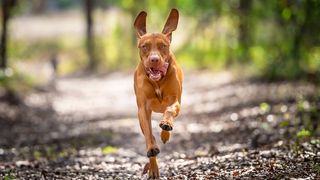
These enthusiastic sporting dogs are natural hunters of upland game and fowl. They can also work as a pointer or retriever and they need so much exercise that it can make you feel tired just hearing about the extent of it. At the very least, Vizlas need to go on stimulating walks in which they’re able to burn off their excess energy but they will also love to play. They don’t have an insulating undercoat, though, so be wary of allowing them to swim in very cold water.
Anatolian Shepherd
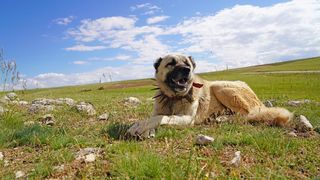
Anatolian Shepherds can’t live entirely outdoors so they will need to be brought inside for a sleep – or, at the very least have a nice, cosy, protective dog house on hand for rest times. But they remain firm outdoor dogs who will happily guard livestock with a level of strong possessiveness and they definitely prefer to be in the countryside than in a city. Able to tolerate cold weather conditions, they will need a good amount of space in which to roam.
Australian Cattle Dog

The Australian Cattle Dog is strong and agile. It is able to work extremely hard and, thanks to having an abundance of energy, it is widely used outdoors for herding on farms or as a running partner. The breed’s uncanny ability to keep going is strong – so much so that one actually has a world record for living until the age of 29 (it’ll have covered a lot of miles in that time). They’re fine working outdoors in wet weather but they will need somewhere dry to lay their head.
Australian Shepherd

Originating in the US at the time of the Gold Rush, the Australian Shepherd is said to be a descendent of the Pyrenean Shepherd, a dog that would herd animals in the Pyrenean Mountains. Since they were bred to work and would be outdoors for the vast majority of the day, they’ve become rather adept at country living and they also make for great farm dogs. All that exercise doesn’t seem to do them much harm either since they live between 12 and 15 years.
German Shorthaired Pointer

These great all-round hunting dogs have loads of energy and they need to be out and about in the great outdoors. That’s not to say there isn’t any peril in allowing them to roam – they have a high prey drive so you need to be mindful of that when letting them off leash – but if you love going on long hikes and you need an outdoor companion, they’ll chomp at the bit to go along with you. Their enthusiastic, people-pleasing nature means they’ll love every second of your adventures.
Belgian Shepherd

Bred as a livestock herding dog, the Belgian Shepherd is a highly-strung breed with a strong prey drive. This dog also needs a lot of exercise and an experienced owner. Super-smart and requiring lots of mental stimulation, the Belgian Shepherd simply can’t be taken for a gentle stroll. Exercise has to be vigorous and long, meaning they’ll be outdoors for long periods of the day. They can also sleep outside so long as they have somewhere secure to offer safe protection.
Norwegian Elkhoun

Norwegian Elkhounds love an outdoor adventure so they’re not really suitable for anyone who spends a lot of time inside. Their endless energy means they always want to explore so keeping them indoors will only lead to despair as they begin to tear up your belongings. That said, you will want them inside at night – although they can live outside even in the cold – they do like company. You’ll certainly bond with them if you love to exercise – get them to run along as you cycle.
Bearded Collie
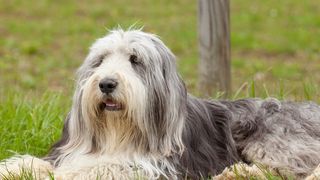
Just look at all that fur! As you can imagine, it requires a lot of maintenance but, at the same time, it’ll keep them warm in colder temperatures. Outgoing and playful, Bearded Collies need to be outdoors a lot of time where they can work, goof around and run. Since they’re larger dogs, it’s a good idea to have plenty of safe, secure room for them to dart around. They can also sleep outside and, if you live on a farm, then you will find they are a wonderful all-weather companion.
Samoyed

Samoyed – or Sammies as they are affectionately known – have worked along humans for centuries. Hailing from Siberia, they are prized for their herding and protective abilities and they have been used to hunt, pull sleds and accompany explorers in the 19th century on expeditions to the North and South Poles. Energetic and in need of walks for about two hours each day, these are dogs to take with your on a long hike. They’ll last longer than you.
Rottweiler
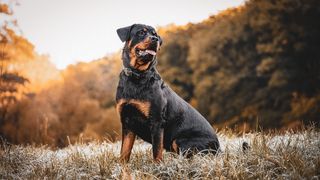
Rottweilers look like tough cookies so if any breed can live outdoors, then surely it’s this one. And the truth is, yes, if a Rottweiler is outdoors in the right climate, they will be perfectly happy with their situation although you would need to ensure they can’t escape. Bred as herding dogs, Rottweilers love to exercise and their coat allows them to adapt to weather changes. They are better in colder climates too. The only problem is that a lack of socialization if left alone for too long can turn this breed aggressive.
Beagle
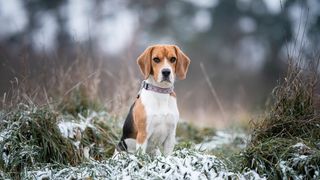
Originally bred as scent hounds, Beagles have long been popular among hunters and they’re also used as sniffer dogs. Since they have a lot of energy, they can spend a lot of time outdoors burning it off. But, the problem for less-energetic owners is that they can go all day at a brisk pace so it can be hard to keep up. Beagles used to be more adept at living outdoors than they are today since they used to snuggle together as packs under shelter but they’re still more comfortable outdoors.
Dalmatian
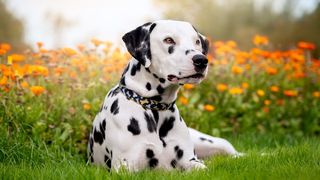
Dalmatians are not the easiest of dogs to live with and they require a lot of commitment. Among those commitments is a need to embark on long walks each day because these dogs are always on the go and they can become destructive or bored very easily if they’re moved to the point of becoming tired. Suitable for sports and as retrievers and trail hounds, Dalmations used to run alongside horse-drawn carriages at some speed. Outdoors is always preferable for this breed.
Jack Russell Terrier

With their high levels of energy and need for an abundance of exercise and interactive play, Jack Russell Terriers were developed to hunt foxes and so thrive outdoors. It is possible for them to live quite happily indoors and outdoors – the main thing is that they know they are being lavished with love and affection, with plenty of human contact. With a penchant for digging and barking, they will need to be in a secure yard and you may want to consider your neighbors too.
German Shepherd

German Shepherds love being outdoors and they don’t mind being in the cold at all. They are insulated by their double fur coat which grows thicker in the winter – the inner layer keeps them warm and the outer layer protects against strong winds. Temperatures above 75 degrees Fahrenheit can be a problem for this breed so it’s important to keep them cool during the Summer. But there’s no doubt German Shepherds love being outside, craving a minimum of two hours of exercise a day.
Siberian Husky

This gorgeous breed is expensive to buy, particularly if you want a working sled dog. But, as you imagine for a pooch which can pull sleighs and sleds as a pack through the snow, this is a breed that is more than capable of living and operating outdoors in freezing temperatures. Hailing from Siberia which is known for its cold climes, the dog is protected by its double coat of fur and it also has bags of energy. They can suffer heat stroke and dehydration in hot temperatures, though,
Rhodesian Ridgeback

Rhodesian Ridgebacks were originally bred to hunt lions and other large game in Africa so that tells you all you need to know about this breed’s outdoor credentials. Since they love to to be in the heat, these dogs are perfectly capable of living outside in hot climates although they do fare less well during cold winters. Easy to train and affectionate, make sure they are in a safe, enclosed area and always have them on a leash when you take them for walks.
Great Pyrenees

Great Pyrenees are very much a definition of an outdoor dog – especially in colder climates. Capable of guarding livestock or pulling a cart, they will happily sleep outdoors even if it’s pouring with rain and they are great if you live on a farm. Just be aware that, despite having tons of stamina, they don’t need a huge amount of exercise and they still like being around people. They don’t fare very well in the heat either and they are difficult to train.
Weimaraner

Weimaraners need a lot of exercise and they love being outdoors. Whether or not that means you should allow them to live outdoors is controversial, however. Weimaraners develop strong bonds with their families and they like to be around them most of the time. So while you can allow a Weimaraner to run about quite happily outside, they should still spend time indoors, particularly at night. The key here is balance. Get it right and you’ll have a very content dog on your hands.
Old English Sheepdog

As one of the most active breeds, Old English Sheepdogs need to be kept mentally and physically stimulated. They need plenty of exercise in order to remain in tip-top shape so let them off a leash when it’s safe to do so and they’ll run around and play happily for ages. Old English Sheepdogs also love to plunge into safe waters for a good swim and they can go on long walks while barely breaking a sweat. They do need to live indoors, though. Too much cold isn’t good for them.
Greater Swiss Mountain Dog

Some dogs are self-descriptive and this is one of them – mountain just screams outdoors. As such, the Swissy, which originated in the Swiss Alps, is very much suited to outdoor life. You can get them to happily pull a cart or a sled and they are very much at home when it’s cold. You need to be careful during the Summer because this breed is sensitive to hot weather but if you are an adventurer and you want a companion who shares your love, this breed is a great choice.
Alaskan Malamute

Although bringing an Alaskan Malamute into your life is not going to be cheap since they are among the most expensive dog breeds, they are nevertheless perfect outdoor dogs. They are capable of living outside and, because they have a thick double coat, they also withstand very cold temperatures. They do fare less well in the Summer, however, so you need to be wary if the temperatures are exceeding 70 degrees Fahrenheit and make sure they have shade.
Labrador retriever
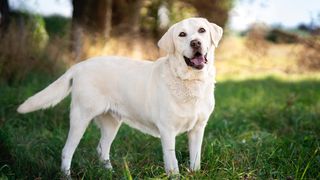
Known to be a high-energy hound, the Labrador Retriever will prove exceptionally lively when you take them outside – which you must do each and every day. They love to run around, chase balls and grab frisbees and they will be very much at home running alongside you if you’re feeling particularly energetic too. But therein lies the warning: the high exercise demands of this breed means you’ll need bags of energy to keep up. Ready for a challenge?
Bernese Mountain Dog

The clue is in the name of this one – a dog that is perfect for outdoor living. Energetic with an even-temper and a people-pleasing nature, the Bernese Mountain Dog has an endless thirst for activity and, if you have a yard, it’s always a good idea to allow them to get out and about as much as possible, presuming it’s safe and secure. They do like to dig enthusiastically so watch out for that. You can also place a backpack on these dogs when out and about to help strengthen their muscles.
Irish Wolfhound

Irish Wolfhounds are gentle giants and, one thing’s for sure, you won’t want them clattering around the house burning off their energy. Get them outside for their two hours of exercise spread across the day, though, and you’ll have a happy dog on your hands. Walks should always be on a leash but you can get up to a gentle jog with no problems. And since this breed has a thick, coarse fur, you don’t need to worry about them being exposed to harsh weather.
American Foxhound

With a love of the great outdoors (or a backyard or local park at least), American Foxhounds are wonderfully energetic dogs. As well as being friendly and intelligent, with a superb sense of smell, they have an independent streak which makes then ideally suited to hunting and tracking. But take them on a hike or a long walk and they will be in their element. You just need to make sure they are always on a leash otherwise there is a strong danger they’ll follow a scent.
PetsRadar Newsletter
Get the best advice, tips and top tech for your beloved Pets
David Crookes has been a journalist for more than 20 years and he has written for a host of magazines, newspapers, websites and books including World of Animals, BBC Earth, Dogs and Canines, Gadget and The Independent. Born in England, he lives in a household with two cats but he’s also keenly interested in the differences between the huge number of dog breeds — in fact, you can read many of his breed guides here on PetsRadar. With a lifelong passion for technology, too, he’s always on the lookout for useful devices that will allow people to spend more time with their pets.

